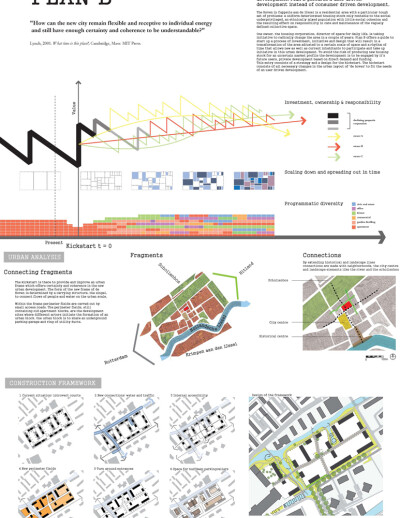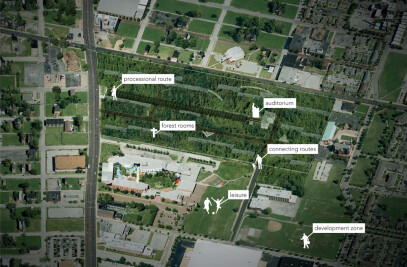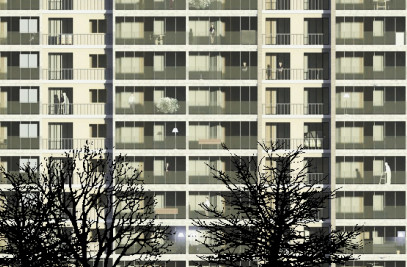Europan 11 proposal
Design team: Marieke Sleijpen Jurrian Arnold Sander Smoes Pieter Graaff
“How can the new city remain flexible and receptive to individual energy and still have enough certainty and coherence to be understandable?” Lynch, 2001. What time is this place?, Cambridge, Mass: MIT Press.
When conventional large-scale urban development has failed the time has come for a new mode of development. Plan B pictures a user driven development instead of consumer driven development.
The Hoven in Cappelle aan den IJssel is a residential area with a particular tough set of problems: a uniform deteriorated housing stock only rentable to the social underprivileged, an ethnically mixed population with little social cohesion and the resulting effect on responsibility in care and maintenance of the vaguely defined collective space.
One owner, the housing corporation, director of space for daily life, is taking initiative to radically change the area in a couple of years. Plan B offers a guide to start up a process of investment, initiative and design that will result in a transformation of the area adjusted to a certain scale of space and a rhythm of time that allows new as well as current inhabitants to participate and take up initiative in this urban development. To avoid the risk of producing new housing stock for an uncertain market profile the development is to be engaged by it’s future users, private development based on direct demand and funding. This entry consists of a strategy and a design for the kickstart. The kickstart consists of all necessary changes in the urban layout of ‘de hoven’ to fit the needs of an user driven development.
Investment, ownership & responsibility A new organization chart is needed to arrange all aspects of maintenance and investment of the neighbourhood. The big regionally organisations will play a different part. Ownership will change from one party to multiple owners. With each new project the real estate will gradually change in a situation where real estate varies greatly in scale, purpose, realisation time, and value. Therefore the value of the real estate in total will no longer drop in time, nor will there be a need to demolish a whole neighbourhood and with that destroy the social cohesion. By allowing all stakeholders (including all inhabitants) to participate in the decision making process for, and inviting them to invest in, the urban space there will be a climate of investment instead of maintenance. Resulting in a gentle rise of social en economical quality of the neighbourhood.
Scaling down and spreading out in time The urban layout is scaled down, allowing projects of various sizes to be formed. Resulting in a variation of project sizes that fits the human scale and easy communication for cooperation. By aiming at a slow transformation process, with small changes at a time, the changes will result in higher appreciation of the neighbourhood in contradiction to total demolition or radical renovation.
Programmatic diversity Economical vitality is only possible in an environment with great opportunities for a great variation of uses. Only then can it change in the same pace as society. ‘Plan B’ will be connected to vital and attractive places in the vicinity of the neighbourhood. Making the experienced distance between front door and those attractions as small as possible. In turn making the plots also interesting for other uses than (social) housing. In time this can result in a great programmatic diversity.
Sustainable neighbourhood metabolism With a joint afford of the corporation, the municipality, the water board, energy suppliers and local entrepreneurs, access to a new infrastructure is created by adapting the existing infrastructure of utility lines for water, sewer, electricity and gas. The grid consists of an easy accessible utility pipe tube in a loop around each urban block. Built directly under the half deep parking cellars. Witch are connected to each other forming a loop an neighbourhood scale. As a result of the design of the grid, inhabitants can plug in sustainable techniques at any given time and great variation in scale. This way in future, earning concepts for utility based sustainable solutions on various scales can easily be implemented. For now, the water structure, part of the kickstart, in particular doesn’t only stimulate new development, but benefits the whole downtown area in purifying gray water and rain water collected on roads and roofs of the buildings surrounding the city centre.
Organising user driven development Starting and organising user driven development demands a new approach. Finding future inhabitants and initiators need to be found even before the realization of the kickstart. For this purpose an interactive internet platform is made. On this website interested parties can get information, view the building fields and a few exemplary or possible concepts. One can propose a concept fitting the parameters of the urban plan, or join one already proposed. Ones there are enough participants to make it probable there will be put up mural on the existing housing block closest to the applied for plot. Once there are enough participants to realize the concept it turns definite. And participants can start design and planning. When there are more than one concepts entered for the same spot, the first to have enough participants will be realized. This can be made visible by a colour code indicating the number of participants. The participants are supported by a platform of professionals. At first via the website, if needed in real life.
In order to reach the less digital inhabitants and potential participants other communication methods can be used. Such as information markets, presentations, newsletters, interviews in the neighbourhood, (interactive) video footage projected on one of the existing blocks or somewhere in the city centre.
A new organization chart is needed to arrange all aspects of maintenance and investment of the neighbourhood. This chart consists of two organization levels. One for each property. And one witch operates on the scale of the neighbourhood. Both consisting of all stakeholders concerned. The organization for each individual property is down to the involved stakeholders. The constantly changing building stock should not result in a constant building site. There for buildings must be build according to the principles of ‘slim bouwen ®’ in order maximize future adaptation possibilities. These flexible properties ensure that even tenants can adapt their homes.
The organization on the scale of the neighbourhood consists of all stakeholders. Their objective is to maintain and invest in the public space. Together they make an maintenance- and investment plan witch has to be approved of by all stakeholders via a general vote. Stakeholders, such as the water board or the energy suppliers, are invited to resolve their responsibilities as local as possible. This way money that normally goes to big regionally organizations will stay local and contribute to the spatial quality. Inhabitants are invited to invest in community shares. This way the neighbourhood can house several earning concepts. The kickstart consists of two earning concepts. The water purification cascade improves the water quality and reduces sewer water for the sewage treatment plant. Inhabitants can participate in the investment needed and in exchange for a tax reduction. And the provided parking space can be used by visitors of the city centre. The earnings of the paid parking can be used for further improvement.
Passing of time After plan B’s kickstart the new urban structure will gradually fill up. Changes expanding from the Europan location to the study area. But changes will constantly occur, the site will never be static. The transformation process will be made visible as soon as the corporation and the municipality agree to Plan B. On the existing housing blocks big murals show possible and later planed projects. Giving inhabitants and passers-by not only an idea of future developments but also the possibility to join an initiative.
Concepts for the current housing blocks With a few simple changes the currant housing blocks will be suitable for various temporary uses. The most important change is the access system. Currently the staircases and the front access is depressing and dark. The main reason being the illogical scheme. The front door is visually separated from the stairs by a concrete wall. Due to the new urban plan the front doors of most remaining blocks have to move to the other side. This allows the ground floor plan to change and improve. The front doors can be transparent and directly opposite the staircase. Witch makes the main hallway clear, light and a better place to enter the shared space of the flat.
In the new urban plan most blocks have a half sunken garage with a roof garden on top on the rear side. By placing a door halfway to the first floor the roof garden will be accessible for all inhabitants from the shared stairs. By replacing (part of) the facade on the (new) front side of the ground floor with one with a greater transparency the adjacent space can be used for living or working purposes. All apartments adjacent to the shared stairs can be used in various ways. These adaptations make them very suitable for a collective of inhabitants, sharing storage and a living room on the ground floor and a roof garden on the rear.
The new urban plan cuts through some of the blocks. Witch means that some parts need to be demolished as part of the kick start. When a block is partly demolished it leaves a bear facade where it has been cut by the new road. The blocks are made with a prefab system called dura coignet consisting of story high building components. This allows the blocks to be partly demolished between each bearing wall. When the accessibility system with connected apartments is left intact no real big changes are needed for the remaining blocks. Only the bear facade needs to be lined with new insulation and cladding.
In some cut blocks the remaining apartments are adjacent to a partly demolished apartment. This allows the inhabitants to expand their living space. Giving them opportunity to build extra rooms, a bigger balcony, a workshop, or even a conservatory.

































